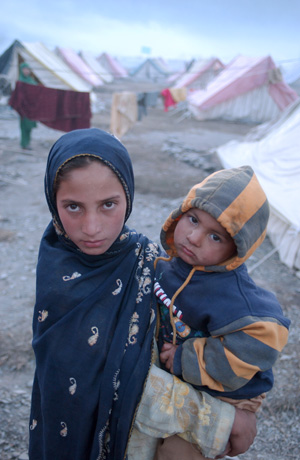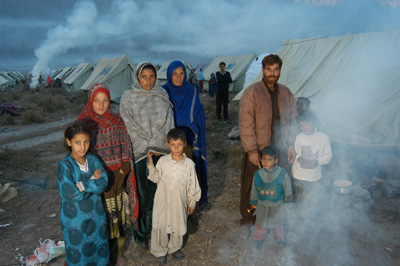
In an article first published in The Sunday Herald Sun, Oxfam worker KATE SIMPSON writes about what’s happened in the aftermath of last year’s devastating earthquake…
Ghulam Din has been living in a camp since an earthquake hit northern Pakistan last year and destroyed his whole village. He owns nothing now apart from the items humanitarian organisations like Oxfam have donated and the few things his family have been able to afford. Today, his only source of income is the small amounts of money he earns when he can get casual labouring work. After a year, even these humble possessions, his tent and the blankets, are looking tired and old and need replacing. “This is no life,” he says.
What he really misses is his land, where he and his family can grow crops. When asked what he would say to the government he responds: “I would plead with them, I would beseech them, I would request them to give me alternative land so that I can rebuild.” At this point there are no plans in place for people like Ghulam.
It’s been a year since a devastating earthquake killed over 70,000 people and left three million homeless in the Pakistan-administered Kashmir and the North-West Frontier Province. For those left behind it’s been a long, slow road to recovery.
I arrived here in January 2006 to work for Oxfam, some three months after the quake. The scene across the region was one of grim-faced adults, rubble, collapsed buildings, huge scars on hillsides where often whole slopes had fallen away taking homes and people with them. The grey skies, freezing temperatures, and mud and slush in camps all added to the general sense of doom in spite of the huge amount of activity taking place to ensure that people were safe and healthy.

SURVIVORS: Shahbaz and her sister Jarra are living at Thuri park, a camp for people left homeless after the earthquake Their mother died in the earthquake. PICTURE: Carlo Heathcote/Oxfam
“Despite the ongoing support and assistance, over 40,000 people are known to be in tents in official camps. Thousands of others are believed to be in unofficial camps and tents close to their home villages; most of these people can’t go home even if they wanted to because their house and land were lost to the quake.”
On of the places severely affected was the city of Balakot. Today its residents face an equally uncertain future. Many are still living in tents or huts on the ruins of their old houses. While the land still exists, they are not allowed to rebuild because two fault lines run through the centre of the town. The government states they will be relocated, but they don’t know when, and what support they will receive to rebuild houses and businesses.
Umer Ziab is a local carpenter who used to have a profitable business and three bedroom house. He now lives in a one bedroom shack with his family. He says he will not move regardless of government decisions. The sentiment reflects a growing frustration amongst the people of Balakot about their fate.
According to the Pakistan authorities, only 17 per cent of the 450,000 affected households have begun building permanent homes. Oxfam estimates at least 80 per cent of the remaining families, equivalent to 1.8 million people, are still living in temporary shelters with the rest staying with friends and relatives. Despite the ongoing support and assistance, over 40,000 people are known to be in tents in official camps. Thousands of others are believed to be in unofficial camps and tents close to their home villages; most of these people can’t go home even if they wanted to because their house and land were lost to the quake.
However, my recent trip to Banseer village in Shamlai valley, showed that for those who have returned there is a sense of slow recovery from the devastation of the earthquake. The terraced mountains are green, the maize is planted and the sounds of rushing water can be heard from almost any point in the village.
Shattered concrete buildings in the town are a grim reminder of the scale of the disaster. However, sunshine, growth and visible signs of reconstruction also give a sense of a people rebuilding their lives and a return to some semblance of normality. There is expertise and skills in these communities, the main things they needed were replacement of lost assets and some technical support. Oxfam supported some 90,000 people to rebuild their livelihoods through cash for work, providing agricultural support, and helping village traders re-establish their businesses.
In Banseer village itself, Oxfam has helped to rehabilitate irrigation channels. Right across the earthquake zone people’s water sources have been disrupted making access to this essential resource difficult for many. All water sources, whether natural, piped or channelled, were vulnerable to the impacts of the earthquake.
In this village, a covered irrigation channel that provided water for both animals and humans, as well as for irrigating the fields, ran for 4,200 meters along the contours of the hillside. It was severely damaged, creating hardship for many families who had to walk for water during the freezing winter months. Oxfam provided engineering advice and materials while the people of the village provided labour and locally available gravel and wood to overcome this problem. Oxfam is helping repair and build water and sanitation schemes for around 220,000 people, including 130 hard-to-reach mountainous areas and village schools, as well as providing water and sanitation assistance to around 10,000 people still in camps
As the second winter approaches, the real challenge now for all those still in tents or temporary shelters is warm housing. Most people in these mountains see this as their number one priority. However, only a fraction have begun building their permanent house. Most have been waiting for government compensation that has been slow in coming. This means many of those who suffered so badly a year ago will again be facing a harsh winter in makeshift shelter. There is now feverish activity preparing for winter.
Many people spent summer in tents. Now most are building simple wood framed structures with tin roofs. The walls can be made of anything available: rubble, wood planks, stone, tin and plastic. These structures keep the snow off, keeping them warm inside.
In every community there are those that are having trouble building even such simple structures because of distance from markets, the costs of materials and, tragically, the loss of family members who could do this sort of work.
One of the things I have enjoyed most in my time here is working with some really talented and committed Pakistanis. Tariq, one of my team members, is a shelter expert. He and I work together to get information about what is working and what isn’t. We then try to coordinate with the government and the UN to improve the support given to communities like those in Banseer village.
Transport costs are one of the biggest barriers to people rebuilding. Most of our work revolves around water schemes and restoring people’s livelihoods. Through this we have good contacts with community groups. Tariq worked out that for about $1,000 a village we can supply a month’s transport. This is enough to make sure that the poorest members of the village have the materials they need and the rest of the village will benefit too. Local water committees manage the process and we brief the existing community committees, hire and pay for the utes and monitor the process. Good one Tariq!


A GRIM ANNIVERSARY
TOP: Dacod Faqeera village – Kali Bagam (foreground) with Rabia (behind) holding her son young Ansar. Behind them is a tent unfit for cold climates and wet conditions as it has no flooring or closing flaps. There are 50 households in this village, with around seven t eight people in each, making about 400 people all together.
BOTTOM: Mohammad Farid with his wife Begum Jan and their family in Thuri park, a camp for people left homeless after the earthquake.
PICTURES: Carlo Heathcote/Oxfam
My most recent trip out of the capital Islamabad highlighted some of the more subtle problems faced by individuals and families. We were travelling with a film crew who wanted to know about some of the problems faced by children affected by the quake. Sometimes it is easy to forget about the psychological impacts on people, as life begins to look more normal.
People tell their stories very stoically and it can take a moment to really feel the impact of what happened that day. A woman I spoke to, Fozia, is a worried 22-year-old mother. Her five-year-old son is struggling each day with going to school. “He is a good boy at home but he is so scared about going to school after all that he has seen,” she tells me.
The school looks safe enough. Built five months after the earthquake and allowing classes to begin again, it is a simple three-wall structure with a red tin roof. The walls are dry stone and only a meter and a half high. The rest is open air. It has been deliberately designed to reduce the fear felt by children. For the little boy it’s still not enough. School is still scary. Just about every day his mother has to make him go. In one sense he is lucky, as many other kids will be going to school in tents for months to come.
My colleagues and I continue highlighting the problems faced by survivors. For instance, poor people have had to pay for expensive building materials. The government eventually changed its policy to allow them to use more familiar, cheap local materials.
We have also pushed hard for them to allow aid agencies to provide materials for temporary shelters for winter. The government was concerned that if they allowed this, it would stop people building permanent houses. The reality is that most people haven’t had the time and unless they wanted many people spending winter in tents, support needed to be provided to them. Now the government has seen the pressing need for this.
We have also been successful at ensuring there are clear procedures for when people need to be relocated. This is important to make sure that they know what their options are, and for those who need special support, medical support for example, that this is put in place.
There are a few issues that we will continue to work on. The big one is landlessness. Every one whose house collapsed will receive a minimum of $2,000 as support. However, if your house and land fell away in a landslide, then you don’t get anything. These people are some of the worst affected, yet they remain in limbo to this day.
For me, being part of the recovery process in an interesting and challenging professional experience. It is much easier for me than for people like Fozia who have to rebuild their whole lives. Like any complex human endeavour, the process of recovery is a patchy one. It is clear that the scale of the catastrophe, difficult mountainous terrain, poor infrastructure, extreme weather conditions, problems with disseminating public information, as well as gaps in support for some vulnerable groups, have hindered the pace of reconstruction
Today, there are people who try and get on with their lives, there are some who are still not sure what to do, and there are those who are waiting for handout. However, across the vast expanse of the northern Pakistan mountains that were rocked by last year’s earthquake, the overwhelming majority of local people, aid workers and the government are working hard to travel the road to recovery as smoothly and quickly as possible. After all, there is still to do.
This article was first published in The Sunday Herald Sun.






